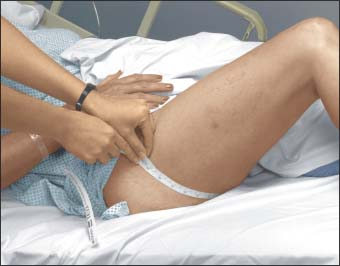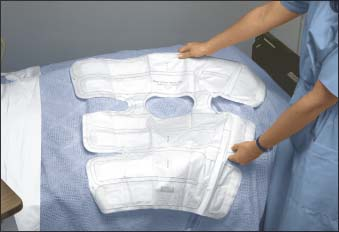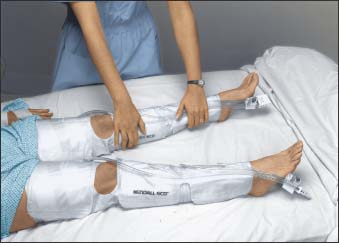Sequential Compression Therapy
Safe, effective, and noninvasive, sequential compression therapy helps prevent deep vein thrombosis (DVT) in surgical patients. This therapy massages the legs in a wavelike, milking motion that promotes blood flow and deters thrombosis.
Typically, sequential compression therapy complements other preventive measures, such as antiembolism stockings and
anticoagulant medications. Although patients at low risk for DVT may require only antiembolism stockings, those at moderate to high risk may require both antiembolism stockings and sequential compression therapy. These preventive measures are continued for as long as the patient remains at risk.
anticoagulant medications. Although patients at low risk for DVT may require only antiembolism stockings, those at moderate to high risk may require both antiembolism stockings and sequential compression therapy. These preventive measures are continued for as long as the patient remains at risk.
Both antiembolism stockings and sequential compression sleeves are commonly used preoperatively and postoperatively because blood clots tend to form during surgery. About 20% of blood clots form in the femoral vein. Sequential compression therapy counteracts blood stasis and coagulation changes, two of the three major factors that promote DVT. It reduces stasis by increasing peak blood flow velocity, helping to empty the femoral vein’s valve cusps of pooled or static blood. Also, the compressions cause an anticlotting effect by increasing fibrinolytic activity, which stimulates the release of a plasminogen activator.
Equipment
Measuring tape and sizing chart for the brand of sleeves you’re using ▪ pair of compression sleeves in correct size ▪ connecting tubing ▪ compression controller.
Implementation
Check the doctor’s order.
Confirm the patient’s identity using at least two patient identifiers according to your facility’s policy.1
Explain the procedure to the patient to increase cooperation.
Determining the Proper Sleeve Size
Before applying the compression sleeve, you must determine the proper size of sleeve that you need.
Measure the circumference of the upper thigh while the patient rests in bed. Do this by placing the measuring tape under the thigh at the gluteal furrow (as shown below).

Hold the tape snugly, but not tightly, around the patient’s leg. Note the exact circumference.
Find the patient’s thigh measurement on the sizing chart, and locate the corresponding size of the compression sleeve.
Remove the compression sleeves from the package and unfold them.
Lay the unfolded sleeves on a flat surface with the cotton lining facing up (as shown below).

Notice the markings on the lining denoting the ankle and the area behind the knee at the popliteal pulse point. Use these markings to position the sleeve at the appropriate landmarks.
Applying the Sleeves
Place the patient’s leg on the sleeve lining. Position the back of the knee over the popliteal opening.
Make sure that the back of the ankle is over the ankle marking.
Starting at the side opposite the clear plastic tubing, wrap the sleeve snugly around the patient’s leg.
Fasten the sleeve securely with the Velcro fasteners. For the best fit, first secure the ankle and calf sections, and then the thigh.
The sleeve should fit snugly but not tightly. Check the fit by inserting two fingers between the sleeve and the patient’s leg at the knee opening. Loosen or tighten the sleeve by readjusting the Velcro fastener.
Using the same procedure, apply the second sleeve (as shown below).

Stay updated, free articles. Join our Telegram channel

Full access? Get Clinical Tree


Get Clinical Tree app for offline access
